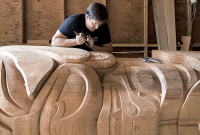Support strong Canadian climate journalism for 2025
Canada wants to be a global tech leader and big things have been happening on that front in recent years. Indigenous Nations want to be global tech leaders, too — and, in fact, we always have been.
Indigenous technology is based on sustainability, universal access and education: from canoes to pyramids, from roads and bridges to cities and trade networks, from teepees that withstood blizzards to nail-free plank longhouses that withstood ocean gales. We managed millions of square miles of land and water, providing the good life for millions of people while protecting waterways and forests and non-human beings.
And this technology was always fused with art. I am Cree and Métis, not from the West Coast, but I remain in awe of the traditional carved halibut hooks of the Haidas, which simultaneously embody science, art, respect for the halibut and the sustainability of its stocks.
Among the many fallacies about Indigenous people is that western technology is beyond our capacity. This despite having shared our extensive knowledge and technology with the newcomers, who used them to survive, then to lay claim to Turtle Island’s resources. We knew where the gold and bitumen were, and our canoes made the Hudson Bay Co.
Indigenous people have always been quick to use new technology, but we always had bigger dreams than simple proficiency or profit. We were driven to advance and enrich our own cultures and communities, particularly our storytelling traditions.
When Indigenous people first gained access to cameras, lighting, audio and filmmaking equipment, they immediately adapted these tools to create films reflecting our stories. We shared these with a world that so often misrepresented Indigenous culture, and we were empowered to push the form’s boundaries to tell these stories with greater intensity and emotion.
My career as an Indigenous filmmaker, artist and activist has allowed me to share my passion for telling stories through technology that advances almost daily. I have had the privilege of working with and mentoring talented and passionate artists, and we have told the truth about Indigenous history, reclaiming our culture from the myths under which colonial oppressors tried to bury it.
The struggle to rebuild our culture continues for new generations of creators. These creators have outstanding abilities and innovative techniques and have engaged Indigenous and non-Indigenous audiences who are hungry for our perspectives.
Many have self-trained in emerging technology. But if we want to create more opportunities, we have to increase access. As founder and creative director of the IM4 Lab in partnership with the Emily Carr University of Art and Design, I can say that the vision is to give filmmakers access to the latest virtual and augmented reality technology training to Indigenize the film industry.
An exciting new element will be added to IM4 Lab soon. The Virtual Production Innovation Studio, a collaboration with the Digital Supercluster’s Talent and Capacity Program, will allow creators to expand their skills to create digital sets and effects that could rival any Hollywood blockbuster.
Virtual production, which uses virtual and augmented reality technologies, has quickly become an essential tool in modern filmmaking. Its Indigenous users might take inspiration from Taika Waititi, a Maori director and producer who has used these technologies to create titles like Thor: Love and Thunder and Our Flag Means Death.
The virtual studio will begin training its first wave of 30 Indigenous creators in the next few weeks. The free program includes extensive training in a virtual production studio, and it will be supervised by a matriarchal governance body, including Tracey Kim Bonneau, Cease Wyss and Doreen Manuel.
These Indigenous women have extensive careers in media and community activism and are dedicated to ensuring community access to these storytelling tools.
With access, we can recreate history and build immersive environments for our stories. People who take this training can walk onto big production sets with confidence and build good careers.
It is important the trainers who work with Indigenous creators have a sensitivity and an understanding of who we are and why these tools are important to us. This model delivers skills development in a context controlled by Indigenous traditions and culture. I hope it can be used to connect Indigenous artists with advanced technology skills in other fields.
This is about making traditional values and culture the foundation of advanced skills development in our community. Technology and skills are not just career builders, but community builders. That’s what makes our approach unique, but it can also be applied beyond the creative fields, in health care, education, environmental science and beyond.
I hope programs like the Virtual Production Innovation Studio can also be models of reconciliation. We have an outstanding opportunity to train a new generation of Indigenous creators to collaborate with the broader industry and turn a camera on our rich history, our modern life and the future of seven generations. In doing so, we can influence Canada’s arts sectors to be more inclusive and reflective.
Loretta Todd is an Indigenous film director and the founder and creative director of IM4 Lab.






Comments
Loretta, thanks for this excellent article and for sharing these perspectives. I agree and look forward to the results. Keep up the great work. I/we are listening.